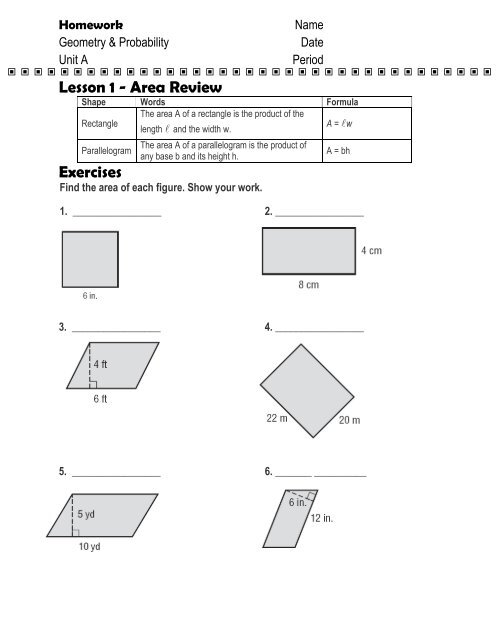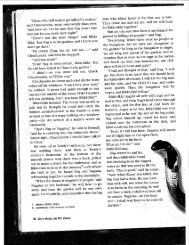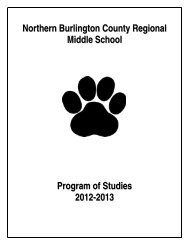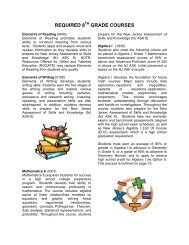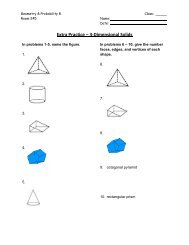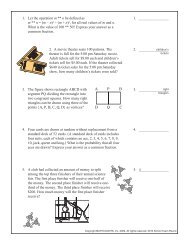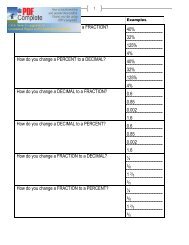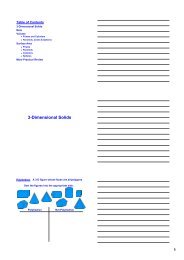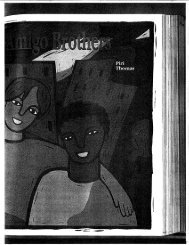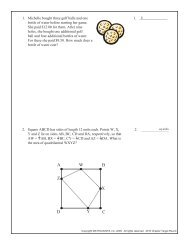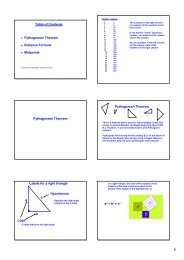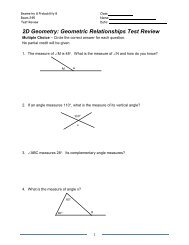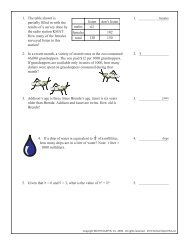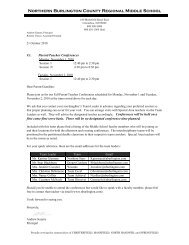Unit A Homework
Unit A Homework
Unit A Homework
You also want an ePaper? Increase the reach of your titles
YUMPU automatically turns print PDFs into web optimized ePapers that Google loves.
<strong>Homework</strong><br />
Geometry & Probability<br />
<strong>Unit</strong> A<br />
Name<br />
Date<br />
Period<br />
<br />
Lesson 1 - Area Review<br />
Shape Words Formula<br />
Rectangle<br />
The area A of a rectangle is the product of the<br />
length and the width w.<br />
A = w<br />
Parallelogram<br />
The area A of a parallelogram is the product of<br />
any base b and its height h.<br />
Exercises<br />
Find the area of each figure. Show your work.<br />
A = bh<br />
1. _________________ 2. _________________<br />
3. _________________ 4. _________________<br />
5. _________________ 6. _______ __________
<strong>Homework</strong><br />
Geometry & Probability<br />
<strong>Unit</strong> A<br />
Name<br />
Date<br />
Period<br />
<br />
Lesson 2 – More Area Review<br />
Shape Words Formula<br />
Triangle<br />
The area A of a triangle is half the product of any<br />
base b and its height h.<br />
A = bh<br />
Trapezoid<br />
The area A of a trapezoid is half the product of<br />
the height h and the sum of the bases, b1 and b2.<br />
Exercises<br />
Find the area of each figure. Show your work.<br />
A = h (b1 + b2)<br />
1. _________________ 2. _________________<br />
3. _________________ 4. _________________<br />
5. _________________ 6. _________________
<strong>Homework</strong><br />
Name<br />
Geometry & Probability<br />
Date<br />
<strong>Unit</strong> A<br />
Period<br />
<br />
Lesson 3- Circumference<br />
center<br />
The diameter, d, is<br />
the distance across a<br />
circle through its<br />
center.<br />
The circumference, C,<br />
is the distance around a<br />
circle<br />
The radius, r, is the<br />
distance from the<br />
center to any point<br />
on a circle.<br />
The diameter of a circle is twice its radius.<br />
d = 2r<br />
The radius is half the diameter. r =<br />
The circumference of a circle is equal to<br />
π times its diameter or π times twice its radius.<br />
Examples<br />
The radius of a circle is 7 meters. Find the<br />
diameter.<br />
Write the formula. d = 2r<br />
Replace r with 7 d = 2 • 7<br />
Multiply d = 14<br />
The diameter is 14 meters.<br />
7 m<br />
C = πd<br />
C = 2πr<br />
Find the circumference of a circle with a radius<br />
that is 13 inches. Use 3.14 for π. Round to the<br />
nearest tenth.<br />
Write the formula.<br />
C = 2πr<br />
Replace r with 13 and π with 3.14. C ≈ 2 • 3.14 • 13<br />
Multiply. C ≈ 81.64<br />
Rounded to the nearest tenth, the circumference<br />
is about 81.6 inches.<br />
Exercises<br />
Find the circumference of each circle. Use 3.14 for π. Round to the nearest tenth if necessary.<br />
Show your work.<br />
1. _________________ 2. _________________ 3. _________________<br />
5 m<br />
8 in. 21 ft
<strong>Homework</strong><br />
Name<br />
Geometry & Probability<br />
Date<br />
<strong>Unit</strong> A<br />
Period<br />
<br />
Lesson 4 - Area of Circles<br />
The area A of a circle equals the product of pi (π) and the square of its radius r. A = πr 2<br />
The formula for the area of a semicircle, or half a circle, is A = πr 2 .<br />
Examples<br />
Find the area of the circle.<br />
Use 3.14 for π.<br />
5 cm<br />
Find the area of a semicircle that has a diameter of<br />
9.4 millimeters. Use 3.14 for π. Round to the<br />
nearest tenth.<br />
A = πr 2<br />
Area of semicircle<br />
Area of circle A = πr 2<br />
Replace π with 3.14 and r with 5. A ≈ 3.14 • 5 2<br />
5 2 = 5 · 5 = 25 A ≈ 3.14 • 25<br />
A ≈ 78.5<br />
The area of the circle is approximately 78.5<br />
square centimeters.<br />
A ≈ • 3.14 • 4.7 2 Replace π with 3.14 and<br />
A ≈ 34.7<br />
r with 9.4 ÷ 2 or 4.7.<br />
Multiply.<br />
The area of the semicircle is approximately 34.7<br />
square millimeters.<br />
Exercises<br />
Find the area of each circle. Round to the nearest tenth. Use 3.14 for π. Show your work.<br />
1. _________________ 2. _________________ 3. _________________<br />
7 in<br />
25 mm<br />
12 ft<br />
Find the area of each semicircle. Round to the nearest tenth. Use 3.14 π. Show your work.<br />
4. _________________ 5. _________________ 6. _________________<br />
28 m<br />
3 ft<br />
GARDENING Vidur needs to buy<br />
mulch for the garden with the<br />
dimensions shown in the figure. For<br />
how much area does Vidur need to<br />
buy mulch?<br />
5.5 yd
<strong>Homework</strong><br />
Geometry & Probability<br />
<strong>Unit</strong> A<br />
Name<br />
Date<br />
Period<br />
<br />
Extended Constructed Response Question 3 2 1 0<br />
Show your work & explain your answer.<br />
John is scuba diving in the ocean. He begins at a depth of -232<br />
feet. He swims down 87 feet to check out a shipwreck, and then<br />
back up 101 feet when he sees a sting ray.<br />
1. What is his current depth?<br />
2. Draw a number line and record the three depths he hits. For example, you<br />
would place a dot at -232 and label this “starting depth.” You must place his<br />
depth after he swims down, and after he swims back up. (there will be three dots on your number line).<br />
3. If 1 ft = 12 in, how many inches under water was John when he started? Explain your answer.<br />
___________________________________________________<br />
___________________________________________________<br />
___________________________________________________<br />
___________________________________________________<br />
___________________________________________________<br />
___________________________________________________<br />
___________________________________________________<br />
___________________________________________________
<strong>Homework</strong><br />
Geometry & Probability<br />
<strong>Unit</strong> A<br />
Name<br />
Date<br />
Period<br />
<br />
Lesson 5- Area of Composite Figures<br />
To find the area of a composite figure, decompose the figure into shapes whose areas you know how<br />
to find. Then find the sum of these areas.<br />
Example<br />
Find the area of the composite figure.<br />
The figure can be separated into a semicircle and trapezoid.<br />
Then, add the areas together.<br />
The area of the figure is about 77.0 + 160 or 237 square inches.<br />
Area of semicircle<br />
Area of trapezoid<br />
14 in.<br />
10 in.<br />
18 in.<br />
14 in.<br />
A = πr 2<br />
A = h(b1 + b2 )<br />
10 in.<br />
A = • π • (7) 2<br />
A ≈ 77.0 in 2<br />
14 in.<br />
A = • 10 • (14 + 18)<br />
A = 160 in 2<br />
18 in.<br />
Exercises<br />
Find the area of each figure. Round to the nearest tenth if necessary. Use 3.14 for π. Show your work.<br />
1. _________________ 2. _________________ 3. _________________<br />
8 mm<br />
5 mm<br />
6 mm<br />
6 ft<br />
9 ft<br />
7 mi<br />
14 mi<br />
5 mi<br />
5 mi<br />
9 ft<br />
4. _________________<br />
SWIMMING POOLS The Cruz family is buying a custom-made cover for their swimming pool, shown below.<br />
The cover costs $2.95 per square foot. How much will the cover cost? Round to the nearest cent.<br />
15 ft<br />
25 ft
<strong>Homework</strong><br />
Geometry & Probability<br />
<strong>Unit</strong> A<br />
Name<br />
Date<br />
Period<br />
<br />
Lesson 6 - Volume of Prisms<br />
The volume of a three-dimensional shape is the measure of space<br />
occupied by it. It is measured in cubic units such of the shape at the right<br />
can be shown using cubes.<br />
The bottom layer,<br />
or base, has 4 • 3<br />
or 12 cubes.<br />
→<br />
There are<br />
two layers.<br />
It takes 12 • 2 or 24 cubes to fill the box. So, the volume of the box is 24 cubic meters.<br />
A rectangular prism is a three-dimensional shape that has two parallel and congruent sides, or<br />
bases, that are rectangles. To find the volume of a rectangular prism, multiply the area of the base<br />
times the height, or find the product of the length , the width w, and the height h.<br />
V = Bh or V = wh<br />
Example<br />
Find the volume of the rectangular prism<br />
V = wh<br />
Volume of a rectangular prism<br />
V = 5 • 6 • 8 Replace with 5, w with 6, and h with 8.<br />
V = 240<br />
Multiply.<br />
The volume is 240 cubic inches.<br />
Exercises<br />
Find the volume of each prism. Round to the nearest tenth. Show your work.<br />
1. _________________ 2. _________________ 3. _________________<br />
STICKY NOTES A triangular box<br />
of sticky notes is shown. Find the<br />
volume of the box.
ANSWERS:<br />
<strong>Homework</strong><br />
Geometry & Probability<br />
<strong>Unit</strong> A<br />
Name<br />
Date<br />
Period<br />
<br />
Mid-<strong>Unit</strong> Test Review<br />
Calculate the correct answer to each problem. When finished, check your answers.<br />
Exercises<br />
Use 3.14 for π. Round to the nearest tenth. Show your work.<br />
1. _______ What is the circumference of the circle?<br />
A. 31. 2 yd C. 88.2 yd<br />
B. 44.1 yd D. 176.5 yd<br />
28.1 yd<br />
2. _______ What is the area of the circle?<br />
A. 1,017.4 mm 2 C. 56.5 mm 2<br />
B. 254.3 mm 2 D. 28.3 mm 2<br />
9 mm<br />
3. _______ A rectangular trunk has a volume of 26,880 cubic inches. The trunk is 4<br />
feet long by 28 inches wide. What is the trunk's height?<br />
A. 20 in. C. 240 in.<br />
B. 60 in. D. 2,880 in.<br />
4. _______ What is volume of the right triangular prism?<br />
A. 93.3m 3 C. 280 m 3<br />
B. 140.3 m 3 D. 560 m 3<br />
4 m 10 m 14 m<br />
5. _________________ What is the area of the figure?<br />
1C, 2B, 3C, 4C, 5 -1156.7 cm 2<br />
18 cm<br />
36 cm
<strong>Homework</strong><br />
Geometry & Probability<br />
<strong>Unit</strong> A<br />
Name<br />
Date<br />
Period<br />
<br />
Extended Constructed Response Question 3 2 1 0<br />
Show your work & explain your answer.<br />
Bart, Lisa and Maggie Simpson order pizza for dinner to share.<br />
Bart eats of a pizza, Lisa eats of a pizza and Maggie<br />
eats<br />
of a pizza.<br />
1. Put the Simpsons in order from who eats the most pizza to who eats the least amount.<br />
2. Create two equivalent fractions for the pizza Maggie ate. Draw a picture to show they are equivalent.<br />
3. Is there any pizza left for Homer? If so, how much?<br />
___________________________________________________<br />
___________________________________________________<br />
___________________________________________________<br />
___________________________________________________<br />
___________________________________________________<br />
___________________________________________________<br />
___________________________________________________<br />
___________________________________________________
<strong>Homework</strong><br />
Name<br />
Geometry & Probability<br />
Date<br />
<strong>Unit</strong> A<br />
Period<br />
<br />
Lesson 7 - Comparing Volume Lab<br />
Cylinder<br />
Volume = πr 2 h<br />
Surface Area = 2πrh + 2πr 2<br />
h<br />
r<br />
Cone<br />
Volume = πr 2 h<br />
Exercises<br />
Find the volume of each shape. Round to the nearest tenth. Use 3.14 for π. Show your work.<br />
1. _________________ 2. _________________<br />
10 in<br />
3 in<br />
3. The track-and-field club is planning a frozen yogurt sale to raise money. They need to buy containers to<br />
hold the yogurt. They must choose between the cup and the cone below. Each container costs the same.<br />
The club plans to charge customers $1.25 for a serving of yogurt. Which container should the club buy?<br />
Why?<br />
___________________________________________________<br />
___________________________________________________<br />
___________________________________________________
<strong>Homework</strong><br />
Geometry & Probability<br />
<strong>Unit</strong> A<br />
Name<br />
Date<br />
Period<br />
<br />
Lesson 8 - Volume of Pyramids<br />
A pyramid is a three-dimensional shape with one base and triangular lateral faces.<br />
The volume V of a pyramid is one third the area of the base B times the height h.<br />
V = Bh<br />
Examples<br />
Find the volume of the pyramid.<br />
Round to the nearest tenth.<br />
V = Bh<br />
Volume of a pyramid<br />
11 m<br />
V = ( w)h The base is a rectangle, so B = w.<br />
4.3 m<br />
3.2 m<br />
V = (4.3 · 3.2) · 11 = 4.3, w = 3.2, h = 11<br />
V ≈ 50.5<br />
Simplify.<br />
The volume is about 50.5 cubic meters.<br />
Exercises<br />
Find the volume of each shape. Round to the nearest tenth. Show your work.<br />
1. _________________ 2. _________________ 3. _________________<br />
6 cm<br />
10 in.<br />
7 in.<br />
10 in.<br />
8 cm<br />
7 cm<br />
13 in. 16 in.<br />
2.3 in.<br />
4. _________________<br />
GATE POST The top of a gate post is in the shape of a square pyramid. The height of the pyramid is 5<br />
inches and each side of the base is 7.4 inches. Find the volume of wood needed . to make the top of the<br />
gate post
<strong>Homework</strong><br />
Geometry & Probability<br />
<strong>Unit</strong> A<br />
Name<br />
Date<br />
Period<br />
<br />
Extended Constructed Response Question 3 2 1 0<br />
Show your work & explain your answer.<br />
Use your reference sheet.<br />
The can of soup below has a radius of 4 cm and a height of 12 cm<br />
1. What is the volume of the soup can?<br />
2. Jeremy eats 65% of the soup for lunch. How much soup did he eat?<br />
3. If Jeremy wants to pour the soup in the can into a Rubbermaid container (a square<br />
prism) that has a side length of 6 cm and a height of 10 cm, how much space will be<br />
left in the container??<br />
___________________________________________________<br />
___________________________________________________<br />
___________________________________________________<br />
___________________________________________________<br />
___________________________________________________<br />
___________________________________________________<br />
___________________________________________________<br />
___________________________________________________
<strong>Homework</strong><br />
Geometry & Probability<br />
<strong>Unit</strong> A<br />
Name<br />
Date<br />
Period<br />
<br />
Lesson 9 - Nets of 3-D Figures Lab<br />
A net is a 2-D pattern for a 3-D shape.<br />
Exercises<br />
Can the pattern be folded along the lines to form a closed rectangular box? Explain for each pattern.<br />
1. YES NO _______________________ 2. YES NO _______________________<br />
__________________________________<br />
__________________________________<br />
__________________________________<br />
__________________________________<br />
3. YES NO _______________________ 4. YES NO _______________________<br />
__________________________________<br />
__________________________________<br />
__________________________________<br />
__________________________________<br />
5. YES NO _______________________ 6. YES NO _______________________<br />
__________________________________<br />
__________________________________<br />
__________________________________<br />
__________________________________
<strong>Homework</strong><br />
Geometry & Probability<br />
<strong>Unit</strong> A<br />
Name<br />
Date<br />
Period<br />
<br />
Lesson 10 – Surface Area of Prisms<br />
The sum of the areas of all the surfaces, or faces, of a three-dimensional shape is the surface area. The<br />
surface area S.A. of a rectangular prism with length , width w, and height h is the sum of the areas of its<br />
faces. S.A. = 2 w + 2 h + 2wh<br />
Examples<br />
Find the surface area of the rectangular prism. Faces Area<br />
3 cm<br />
4 m<br />
3 cm<br />
3 m<br />
7 cm<br />
2 m<br />
2 m<br />
4.9 ft<br />
top and bottom 2 (4 · 3) = 24<br />
front and back 2 (4 · 2) = 16<br />
two sides 2 (2 · 3) = 12<br />
sum of the areas 24 + 16 + 12 = 52<br />
Alternatively, replace with 4, w with 3,<br />
and h with 2 in the formula for surface area.<br />
S. A. = 2 w + 2 h + 2wh<br />
= 2 (4 · 3) + 2 (4 · 2) + 2 (3 · 2)<br />
= 24 + 16 + 12<br />
= 52<br />
So, the surface area of the rectangular prism is 52 square meters.<br />
4 m<br />
back<br />
4 m<br />
2 m<br />
side bottom side<br />
2 m<br />
3 m<br />
front<br />
top<br />
3 m<br />
Exercises<br />
Find the surface area of each prism. Show your work.<br />
1. _________________ 2. _________________ 3. _________________<br />
3 ft<br />
0.7 ft<br />
8 mm<br />
15 mm<br />
17 mm<br />
9 mm<br />
4. _________________<br />
CONTAINERS A company needs to package hazardous chemicals in special plastic rectangular prism<br />
containers that hold 80 cubic feet. Find the whole number dimensions of the container that would use the<br />
least amount of plastic.
<strong>Homework</strong><br />
Name<br />
Geometry & Probability<br />
Date<br />
<strong>Unit</strong> A<br />
Period<br />
<br />
Lesson 11 – Relating Surface Area and Volume Lab<br />
Surface Area of a Rectangular Prism = 2 w + 2 h + 2wh<br />
Volume of a Rectangular Prism = wh<br />
To find the surface area of a triangular prism, it is more efficient<br />
to find the area of each face and calculate the sum of all the<br />
faces rather than use a formula<br />
Exercises<br />
Each of these boxes holds 36 ping-pong balls.<br />
Volume of a Prism = Bh<br />
Box D<br />
Box A<br />
Box B<br />
Box C<br />
1. Without figuring, which box has the least surface area? Explain.<br />
___________________________________________________<br />
___________________________________________________<br />
Find the surface area of each box. Show your work.<br />
2. ______________ 3. ______________ 4. ______________ 5. ______________<br />
6. Draw a sketch of a triangular prism with a<br />
volume of 120 cubic units and a surface area<br />
of 184 square units. Label the dimensions.<br />
HINT: The triangle is an isosceles triangle<br />
with two sides with a length of 5 units.
ANSWERS:<br />
1B, 2B, 3C, 4C, 5-14 in<br />
<strong>Homework</strong><br />
Geometry & Probability<br />
<strong>Unit</strong> A<br />
Name<br />
Date<br />
Period<br />
<br />
Mid-<strong>Unit</strong> Test Review<br />
Calculate the correct answer to each problem. When finished, check your answers.<br />
Exercises Show your work. Round to the nearest tenth, if necessary.<br />
1. _______ What is the volume of the pyramid?<br />
A. 32 in 3 C. 72 in 3<br />
B. 48 in 3 D. 144 in 3<br />
6 in.<br />
4 in.<br />
6 in.<br />
2. _______ What is the volume of the pyramid?<br />
A. 2,352 m 3 C. 1,176 m 3<br />
B. 392 m 3 D. 261.3 m 3<br />
7 m<br />
24 m<br />
14 m<br />
25 m<br />
3. _______ What is the surface area of the figure?<br />
A. 185 m 2 C. 370 m 2<br />
B. 231 m 2 D. 462 m 2<br />
6 m<br />
4. _______ What is volume of the right triangular prism?<br />
A. 134 ft 2 C. 288 ft 2<br />
B. 144 ft 2 D. 336 ft 2<br />
11 m<br />
12 ft<br />
6 ft<br />
8 ft<br />
10 ft<br />
7 m<br />
5. _________________ A drawer is shaped like a rectangular prism. It has a length<br />
of 17 inches and a height of 6 inches. The volume is 1,428 cubic inches. Find the<br />
width of the drawer.<br />
Remember: your test will include all the lessons from the start of the unit. Go back over all previous materials.
<strong>Homework</strong><br />
Geometry & Probability<br />
<strong>Unit</strong> A<br />
Name<br />
Date<br />
Period<br />
<br />
Extended Constructed Response Question 3 2 1 0<br />
Show your work & explain your answer.<br />
A company will make a cereal box with whole number<br />
dimensions and a volume of 100 cubic centimeters.<br />
1. Make a list of all the possible box dimensions.<br />
2. If cardboard costs $0.05 per 100 square centimeters, what is<br />
the least cost to make 100 boxes? Explain.<br />
___________________________________________________<br />
___________________________________________________<br />
___________________________________________________<br />
___________________________________________________<br />
___________________________________________________<br />
___________________________________________________<br />
___________________________________________________<br />
___________________________________________________
<strong>Homework</strong><br />
Geometry & Probability<br />
<strong>Unit</strong> A<br />
Name<br />
Date<br />
Period<br />
<br />
Lesson 12 – Surface Area of Pyramids<br />
The total surface area S.A. of a regular pyramid is the<br />
lateral area L.A. plus the area of the base.<br />
S.A. = B + L.A. or S.A. = B + P<br />
Examples<br />
Find the total surface area of the pyramid.<br />
6 in.<br />
Find the total surface area of the pyramid.<br />
5 m<br />
Perimeter<br />
of base P<br />
Slant<br />
height<br />
Area of<br />
base B<br />
Surface area of a pyramid<br />
S.A. = B +<br />
P<br />
7 in.<br />
7 in.<br />
S.A. = 49 + (28 ∙ 6) P = 4(7)= 28, = 6, B = 7 · 7= 49<br />
S.A. = 133<br />
Simplify.<br />
The surface area of the pyramid is 133 square<br />
inches.<br />
6 m 6 m<br />
6 m<br />
S.A. = 15.6 + (18 ∙ 5) P = 3(6)= 18, = 5, B = 15.6<br />
S.A. = 60.6<br />
area of base<br />
15.6 m 2<br />
Simplify.<br />
The surface area of the pyramid is 60.6 square<br />
meters.<br />
Exercises<br />
Find the total surface area of each pyramid. Round to the nearest tenth. Show your work.<br />
1. _________________ 2. _________________ 3. _________________<br />
2 ft<br />
3 ft<br />
2 ft<br />
TENT The Summers children are<br />
camping out in the tent shown.<br />
7 cm<br />
Find the lateral area of the tent.<br />
4 cm<br />
9 ft.<br />
4 cm 4 cm<br />
area of base<br />
6.9 cm 2<br />
12 ft.<br />
12 ft.
<strong>Homework</strong><br />
Geometry & Probability<br />
<strong>Unit</strong> A<br />
Name<br />
Date<br />
Period<br />
<br />
Lesson 13-Volume of Composite Figures<br />
Find the volume of each shape, then add together.<br />
Example<br />
The figure is made up of a rectangular prisms.<br />
V = lwh + lwh<br />
V = 2 • 1 • 1 + 2 • 0.5 • 0.5<br />
V = 2 + 0.5<br />
The volume of the composite figure is 2.5 cubic meters.<br />
Exercises<br />
Find the volume of the composite figure. Show your work.<br />
1. _________________ 2. _________________ 3. _________________<br />
6 ft<br />
10 ft<br />
4 in<br />
20 ft<br />
10 ft<br />
4 in<br />
8 in<br />
10 in<br />
4. Draw an example of a composite figure that has a volume between 250 and 300 cubic units.
<strong>Homework</strong><br />
Geometry & Probability<br />
<strong>Unit</strong> A<br />
Name<br />
Date<br />
Period<br />
<br />
Lesson 14- Surface Area of Composite Figures<br />
The circle, is A = πr 2 .<br />
Example<br />
To find the surface area, find the area of exposed surfaces.<br />
The lateral area of the prism is 50 + 10 + 50 + 10 = 120 m 2 .<br />
The area of the bottom of the prism is 10 × 2 = 20 m 2 .<br />
The surface area of the triangular prism is 2 + 2 + 28 + 20 = 52 m 2 .<br />
So, the surface area is 120 + 20 + 52 = 192 m 2 .<br />
Exercises<br />
Find the surface area of each figure. Show your work.<br />
1. _________________ 2. _________________ 3. _________________<br />
10 m<br />
6 m<br />
16 m<br />
4 m<br />
5 m<br />
4. _________________<br />
FLOWER BOX Find the surface area of the open-top flower box shown.
<strong>Homework</strong><br />
Geometry & Probability<br />
<strong>Unit</strong> A<br />
Name<br />
Date<br />
Period<br />
<br />
Extended Constructed Response Question 3 2 1 0<br />
Show your work & explain your answer.<br />
Look at the following expression.<br />
117 – 3(4 + 2) 2 + 6<br />
Part A<br />
What are the first two steps you would take to find the value of this expression?<br />
Explain.<br />
Part B<br />
Find the value of the expression. Be sure to rewrite the expression after each step.<br />
___________________________________________________<br />
___________________________________________________<br />
___________________________________________________<br />
___________________________________________________<br />
___________________________________________________<br />
___________________________________________________<br />
___________________________________________________<br />
___________________________________________________


